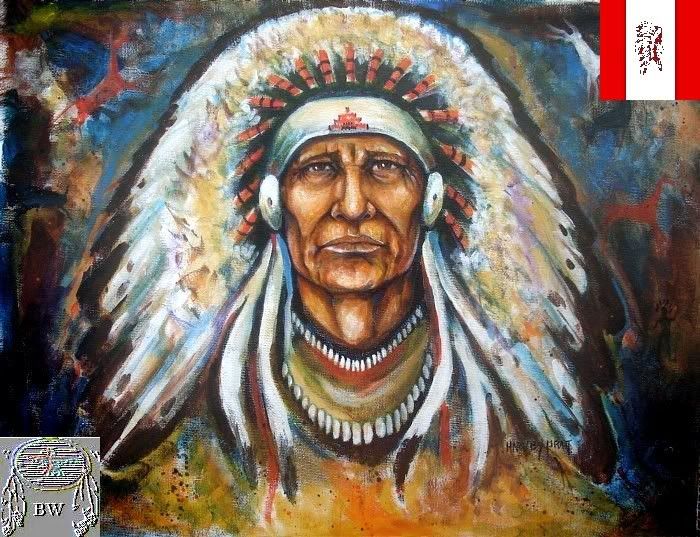|
BRAVEHORSE WARRIOR Tatankanajin
Dakota Warrior

 Chief Tatankanajin
Warrior Citation
TATANKA-NAJIN (known as Standing Buffalo), hereditary chief of the Sisseton-Santee Dakotas; b. c. 1820 at Otter Tail (Minn.);
d. 1870 at Wolf Point, Montana.
Following the Traverse-des-Sioux treaty (1851) with the United States government, the Santee division of the Dakotas
(also known as Sioux), comprising four bands, were allotted reservations along the upper Minnesota River in a rich land that
settlers soon found attractive. Two of the bands, the Sisseton and Wahpeton, were in the 1860s living and hunting in the area
around the Upper Agency (Granite Falls, Minn.); the Wakantonwan and Mdewakantonwan bands were largely in the area around the
Lower Agency (near Redwood Falls, Minn.). The outbreak of the American Civil War interrupted the payment of treaty money;
in 1862 no payment was received. In August of that year some of Standing Buffalo’s band seized supplies but then withdrew
from the agency area. However, later that month the Lower Agency Santees, hungry and defiant, broke into government stores,
and killed many settlers, taking food and supplies. Standing Buffalo refused to join forces with these bands, upbraiding their
chiefs such as Taoyateduta (Little Crow); he forbade them access to his reservation and protected settlers against further
attacks where possible. General Henry Hastings Sibley, sent by the United States government to quell the Indians, for the
next few years pursued both those who had fought and those who had remained neutral. Standing Buffalo narrowly rescued his
band from a battle at Big Mound, Iowa, in 1863. The bands took refuge in the Dakota territory; in the years 1862–64
numbers appeared in British territory around Red River, often starving. Standing Buffalo, who had made a peace agreement with
the Saulteaux on the Souris River (Man.), seems not to have been uneasy about crossing the boundary into British territory
in the spring of 1864, leading some 500 refugees to Upper Fort Garry (Winnipeg). The hope of all the Sioux was that the British
would honour a pledge of assistance made in 1778 at Montreal, when several Dakota chiefs, including Sissetons, were given
King George III silver medals in recognition of assistance during the American revolution. The Dakotas claimed also to have
favoured the British side in the War of 1812. Governor William Mactavish of Assiniboia urged Standing Buffalo to return peacefully
to the United States. His reluctance to render aid can be explained by caution because of lack of supplies, unwillingness
to take sides in an American conflict, and also the long record of clashes between Dakotas and the Saulteaux of the Red River
country. These Indians had been hereditary enemies from the days when the latter had driven the Dakotas south and west to
the plains; in the mid 1840s this enmity had been given a temporary lull only in a peace arranged by the Métis leader, Cuthbert
James Grant; in 1851 and 1853 there were fierce battles between the Dakotas and Métis buffalo hunters.
Chief Tatankanajin
Warrior Citation
TATANKA-NAJIN (known as Standing Buffalo), hereditary chief of the Sisseton-Santee Dakotas; b. c. 1820 at Otter Tail (Minn.);
d. 1870 at Wolf Point, Montana.
Following the Traverse-des-Sioux treaty (1851) with the United States government, the Santee division of the Dakotas
(also known as Sioux), comprising four bands, were allotted reservations along the upper Minnesota River in a rich land that
settlers soon found attractive. Two of the bands, the Sisseton and Wahpeton, were in the 1860s living and hunting in the area
around the Upper Agency (Granite Falls, Minn.); the Wakantonwan and Mdewakantonwan bands were largely in the area around the
Lower Agency (near Redwood Falls, Minn.). The outbreak of the American Civil War interrupted the payment of treaty money;
in 1862 no payment was received. In August of that year some of Standing Buffalo’s band seized supplies but then withdrew
from the agency area. However, later that month the Lower Agency Santees, hungry and defiant, broke into government stores,
and killed many settlers, taking food and supplies. Standing Buffalo refused to join forces with these bands, upbraiding their
chiefs such as Taoyateduta (Little Crow); he forbade them access to his reservation and protected settlers against further
attacks where possible. General Henry Hastings Sibley, sent by the United States government to quell the Indians, for the
next few years pursued both those who had fought and those who had remained neutral. Standing Buffalo narrowly rescued his
band from a battle at Big Mound, Iowa, in 1863. The bands took refuge in the Dakota territory; in the years 1862–64
numbers appeared in British territory around Red River, often starving. Standing Buffalo, who had made a peace agreement with
the Saulteaux on the Souris River (Man.), seems not to have been uneasy about crossing the boundary into British territory
in the spring of 1864, leading some 500 refugees to Upper Fort Garry (Winnipeg). The hope of all the Sioux was that the British
would honour a pledge of assistance made in 1778 at Montreal, when several Dakota chiefs, including Sissetons, were given
King George III silver medals in recognition of assistance during the American revolution. The Dakotas claimed also to have
favoured the British side in the War of 1812. Governor William Mactavish of Assiniboia urged Standing Buffalo to return peacefully
to the United States. His reluctance to render aid can be explained by caution because of lack of supplies, unwillingness
to take sides in an American conflict, and also the long record of clashes between Dakotas and the Saulteaux of the Red River
country. These Indians had been hereditary enemies from the days when the latter had driven the Dakotas south and west to
the plains; in the mid 1840s this enmity had been given a temporary lull only in a peace arranged by the Métis leader, Cuthbert
James Grant; in 1851 and 1853 there were fierce battles between the Dakotas and Métis buffalo hunters.
 Having wintered in the Dakota territory after his lack of success in Red River, Standing Buffalo and his band returned
to Upper Fort Garry again in the spring of 1866. Again they were sent away without the food, guns, and ammunition they requested.
Hunting the buffalo in Assiniboia, they were attacked by Saulteaux, and moved west to the Wood Mountain area (Sask.). While
they were camping on the Souris River in 1869 most of Standing Buffalo’s family died of smallpox. In despair he joined
a Dakota war party in Montana, where he was slain the next year by enemies. Standing Buffalo’s son Matokinajin became
leader of the band in 1878 and obtained a reserve near what is now Fort Qu’Appelle, Sask. Descendants of Santee refugees
live today on several reserves in Manitoba and Saskatchewan. The experience of these groups of dispossessed and wandering
Dakotas was to be repeated when in the next decade Sitting Bull fled to Canada. From: historical accounts & records
Having wintered in the Dakota territory after his lack of success in Red River, Standing Buffalo and his band returned
to Upper Fort Garry again in the spring of 1866. Again they were sent away without the food, guns, and ammunition they requested.
Hunting the buffalo in Assiniboia, they were attacked by Saulteaux, and moved west to the Wood Mountain area (Sask.). While
they were camping on the Souris River in 1869 most of Standing Buffalo’s family died of smallpox. In despair he joined
a Dakota war party in Montana, where he was slain the next year by enemies. Standing Buffalo’s son Matokinajin became
leader of the band in 1878 and obtained a reserve near what is now Fort Qu’Appelle, Sask. Descendants of Santee refugees
live today on several reserves in Manitoba and Saskatchewan. The experience of these groups of dispossessed and wandering
Dakotas was to be repeated when in the next decade Sitting Bull fled to Canada. From: historical accounts & records
|

